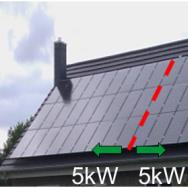 The FLX series has flexibility in layouts that make it ideal for rooftops. With the portfolio starting at 5kW, small to medium rooftops will be able to take advantage of the benefits of this three phase, transformerless inverter series. With the complete portfolio of 5kW, 6kW, 7kW, 8kW, 9kW, 10kW, 12.5 kW, 15 kW and 17kW, the product fits to any residential rooftop.
The FLX series has flexibility in layouts that make it ideal for rooftops. With the portfolio starting at 5kW, small to medium rooftops will be able to take advantage of the benefits of this three phase, transformerless inverter series. With the complete portfolio of 5kW, 6kW, 7kW, 8kW, 9kW, 10kW, 12.5 kW, 15 kW and 17kW, the product fits to any residential rooftop.
The wide MPP range of 250-800V combined with the high efficiency and the two MPP trackers means that layouts of non-identical short or long strings are possible within the same inverter without compromising yield. This enables full utilisation of rooftop areas of different inclination and orientation.
Every single PV installation has to contend with the varying seasonal declination of the sun’s path. In particular, residential rooftop installations are subject to situations where partial shading affects the most productive power point.
“With the growing trend towards roof-based and domestic installations, shading from trees, chimneys, air ducts and lamp posts means that performing regular, accurate PV sweeps to find the maximum power point has become increasingly relevant,” said Dr.Søren B. Kjær, lead system technology engineer at Danfoss Solar Inverters. The FLX series therefore includes an advanced PV sweep functionality, which ensures that PV Sweep is activated at specific periods of the day, when shading occur.
The PV sweep algorithm recognises that as partial shading occurs, numerous “local” power points develop. The FLX inverter performs a sweep over the whole MPP range and determines the most optimal of the multiple local power points, quickly recognizing and utilizing this peak “global” power point. This makes it possible to maximise yield under partially shaded conditions and to account for seasonal variations in the sun’s path.
It is proven that regular PV sweeps can significantly increase the output of a string during shading conditions. “It’s easy to demonstrate with an example – this is from my installation at home. My house has a prominent chimney. One input is subjected to a shadow from the chimney for about 1½ hours a day. Without PV sweep this string produced around 0.5 kWh over these 1½ hours. With PV sweep, the same input now produces 1.4 kWh, which translates into a yield increase of approximately 280%,” Dr.Søren B. Kjær concluded.
Shading is not the only thing that may influence the power output of the PV installation. Power limitation legislation is also something that certain regions are subjected to. The FLX series therefore includes a yield increasing algorithm called Adaptive Consumption Compensation (ACC), which ensures that although the installation is limited by e.g. the 70% rule in Germany or a similar power limitation, it is still possible to utilise the full power potential of the PV system. When self-consumption occurs, the inverter acknowledges it through the S0 output of the energy meter and calculates it in. Hence the inverter adds the power consumed by domestic appliances to the 70% power output allowance at the PCC and then produces that amount. In this way the full power potential of the installation is utilized while still only delivering 70% to the grid.
The self-consumption, power production and delivery to the grid, as well as all other system parameters can be monitored directly from the inverter. Integrated into all inverters in the FLX series there is a full monitoring interface. From a web browser, simply logon to the inverter using the IP address. The interface is very visual and provides the end-user with an easy overview of the system. It is also possible to connect tablets or smart phones directly to the inverter via the Danfoss SolarApp for remote monitoring.

